Chris Eboch's Blog, page 17
November 25, 2016
#Holiday Gift Guide: Nonfiction – Writing, Cooking and More!
I’m continuing with my Holiday Gift Guide. You can see the earlier posts for Great Books for Middle Grade and Teen Readers, Picture Books for Children, and Romance, Romance, #Romance.
 Today I have a few more titles for Nonfiction: Writing, Cooking and More.
Today I have a few more titles for Nonfiction: Writing, Cooking and More.
You Can Write for Children: How to Write Great Stories, Articles, and Books for Kids and Teenagers:
When you write for children, you have the most appreciative audience in the world. But to reach that audience, you need to write fresh, dynamic stories, whether you’re writing rhymed picture books, middle grade mysteries, edgy teen novels, nonfiction, or something else.
Learn how to find ideas and develop those ideas into stories, articles, and books. Understand the basics of character development, plot, setting, and theme – and some advanced elements, along with how to use point of view, dialogue, and thoughts. Finally, learn about editing your work and getting critiques.
You Can Write for Children : How to Write Great Stories, Articles, and Books for Kids and Teenagers is available for the Kindle, in paperback, or in Large Print paperback.
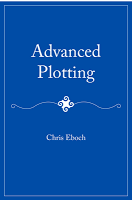 Advanced Plotting is designed for the intermediate and advanced writer: you’ve finished a few manuscripts, read books and articles on writing, taken some classes, attended conferences. But you still struggle with plot, or suspect that your plotting needs work. This book can help.
Advanced Plotting is designed for the intermediate and advanced writer: you’ve finished a few manuscripts, read books and articles on writing, taken some classes, attended conferences. But you still struggle with plot, or suspect that your plotting needs work. This book can help.
This really is helping me a lot. It's written beautifully and to-the-point. The essays really help you zero in on your own problems in your manuscript. The Plot Outline Exercise is a great tool!
I just read and—dissected—your well written book: Advanced Plotting. It's now highlighted in bright orange and littered with many of those little 3M sticky labels. GOOD JOB. There are too many just-for-beginners books out there. Yours was a delight.
See these and more at www.chriseboch.com or my Amazon page.
 If youire interested in history, archaeology, or quirky true stories, try Outlaws & Outcasts: The Lost Cemetery of Las Vegas, New Mexico, by Ellen S. Rippel
If youire interested in history, archaeology, or quirky true stories, try Outlaws & Outcasts: The Lost Cemetery of Las Vegas, New Mexico, by Ellen S. Rippel
Outlaws and Outcasts. They lay undisturbed and forgotten for almost a century--until a backhoe driver digging for gravel made a gruesome discovery. A hastily-assembled group of students, guided by an intellectually curious professor, had only one week to document the unearthing of the large, 19th century graveyard. Who was buried in those unmarked graves? What had they done to be cast out from society? Filled with stories of early outlaws and fascinating historical insights, Outlaws and Outcasts chronicles a spellbinding and little-known saga from New Mexico. For those who love history, archaeology, or quirky stories from the Land of Enchantment, this book is an intriguing summary of what occurred in Las Vegas, New Mexico in 1972. Outlaws and Outcasts: The Lost Cemetery of Las Vegas, New Mexico recounts the accidental unearthing of graves in a gravel pit. Included in the narrative are examinations of historical burial practices and customs, and a search through the scarce literature on events specific to the existence of the cemetery.
Get it from Amazon.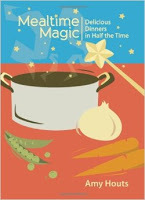 Amy Houts is the author of Mealtime Magic: Delicious Dinners in Half the Time
Amy Houts is the author of Mealtime Magic: Delicious Dinners in Half the Time
• Save $500/year • Spend fewer hours in the kitchen • Please picky eaters • A tried-and-true method
Use the recipes and strategies in this unique cookbook to help you save time and money. Over 200 pages of recipes with clear, detailed directions will help your cooking earn rave reviews even from picky eaters. Award-winning cookbook author Amy Houts shares her time-tested, proven method of intentional planning to provide delicious, home-cooked meals and spend fewer hours in the kitchen.
Also from Amy Houts comes this Cooperative Board Game in a consumable book.
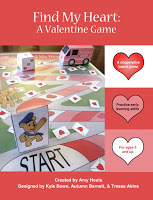 Find My Heart: A Valentine GameOn a windy February day, Valentine Heart Cards have blown out of the Mail Truck and are littering the neighborhood! Can you help the Teddy Bear Mail Carrier collect the Valentine Heart Cards and return them to the Mail Truck? Develops fine motor control and fosters cooperation. Children learn to follow rules, practice counting skills, and more. Research shows that cooperative games help to prevent bullying. Book includes game board, game pieces, rules and instructions. Just cut out pieces, tape, and go!
Find My Heart: A Valentine GameOn a windy February day, Valentine Heart Cards have blown out of the Mail Truck and are littering the neighborhood! Can you help the Teddy Bear Mail Carrier collect the Valentine Heart Cards and return them to the Mail Truck? Develops fine motor control and fosters cooperation. Children learn to follow rules, practice counting skills, and more. Research shows that cooperative games help to prevent bullying. Book includes game board, game pieces, rules and instructions. Just cut out pieces, tape, and go!
See all of Amy Hout’s books at her website or on Amazon.
 Today I have a few more titles for Nonfiction: Writing, Cooking and More.
Today I have a few more titles for Nonfiction: Writing, Cooking and More.You Can Write for Children: How to Write Great Stories, Articles, and Books for Kids and Teenagers:
When you write for children, you have the most appreciative audience in the world. But to reach that audience, you need to write fresh, dynamic stories, whether you’re writing rhymed picture books, middle grade mysteries, edgy teen novels, nonfiction, or something else.
Learn how to find ideas and develop those ideas into stories, articles, and books. Understand the basics of character development, plot, setting, and theme – and some advanced elements, along with how to use point of view, dialogue, and thoughts. Finally, learn about editing your work and getting critiques.
You Can Write for Children : How to Write Great Stories, Articles, and Books for Kids and Teenagers is available for the Kindle, in paperback, or in Large Print paperback.
 Advanced Plotting is designed for the intermediate and advanced writer: you’ve finished a few manuscripts, read books and articles on writing, taken some classes, attended conferences. But you still struggle with plot, or suspect that your plotting needs work. This book can help.
Advanced Plotting is designed for the intermediate and advanced writer: you’ve finished a few manuscripts, read books and articles on writing, taken some classes, attended conferences. But you still struggle with plot, or suspect that your plotting needs work. This book can help.This really is helping me a lot. It's written beautifully and to-the-point. The essays really help you zero in on your own problems in your manuscript. The Plot Outline Exercise is a great tool!
I just read and—dissected—your well written book: Advanced Plotting. It's now highlighted in bright orange and littered with many of those little 3M sticky labels. GOOD JOB. There are too many just-for-beginners books out there. Yours was a delight.
See these and more at www.chriseboch.com or my Amazon page.
 If youire interested in history, archaeology, or quirky true stories, try Outlaws & Outcasts: The Lost Cemetery of Las Vegas, New Mexico, by Ellen S. Rippel
If youire interested in history, archaeology, or quirky true stories, try Outlaws & Outcasts: The Lost Cemetery of Las Vegas, New Mexico, by Ellen S. RippelOutlaws and Outcasts. They lay undisturbed and forgotten for almost a century--until a backhoe driver digging for gravel made a gruesome discovery. A hastily-assembled group of students, guided by an intellectually curious professor, had only one week to document the unearthing of the large, 19th century graveyard. Who was buried in those unmarked graves? What had they done to be cast out from society? Filled with stories of early outlaws and fascinating historical insights, Outlaws and Outcasts chronicles a spellbinding and little-known saga from New Mexico. For those who love history, archaeology, or quirky stories from the Land of Enchantment, this book is an intriguing summary of what occurred in Las Vegas, New Mexico in 1972. Outlaws and Outcasts: The Lost Cemetery of Las Vegas, New Mexico recounts the accidental unearthing of graves in a gravel pit. Included in the narrative are examinations of historical burial practices and customs, and a search through the scarce literature on events specific to the existence of the cemetery.
Get it from Amazon.
 Amy Houts is the author of Mealtime Magic: Delicious Dinners in Half the Time
Amy Houts is the author of Mealtime Magic: Delicious Dinners in Half the Time• Save $500/year • Spend fewer hours in the kitchen • Please picky eaters • A tried-and-true method
Use the recipes and strategies in this unique cookbook to help you save time and money. Over 200 pages of recipes with clear, detailed directions will help your cooking earn rave reviews even from picky eaters. Award-winning cookbook author Amy Houts shares her time-tested, proven method of intentional planning to provide delicious, home-cooked meals and spend fewer hours in the kitchen.
Also from Amy Houts comes this Cooperative Board Game in a consumable book.
 Find My Heart: A Valentine GameOn a windy February day, Valentine Heart Cards have blown out of the Mail Truck and are littering the neighborhood! Can you help the Teddy Bear Mail Carrier collect the Valentine Heart Cards and return them to the Mail Truck? Develops fine motor control and fosters cooperation. Children learn to follow rules, practice counting skills, and more. Research shows that cooperative games help to prevent bullying. Book includes game board, game pieces, rules and instructions. Just cut out pieces, tape, and go!
Find My Heart: A Valentine GameOn a windy February day, Valentine Heart Cards have blown out of the Mail Truck and are littering the neighborhood! Can you help the Teddy Bear Mail Carrier collect the Valentine Heart Cards and return them to the Mail Truck? Develops fine motor control and fosters cooperation. Children learn to follow rules, practice counting skills, and more. Research shows that cooperative games help to prevent bullying. Book includes game board, game pieces, rules and instructions. Just cut out pieces, tape, and go!See all of Amy Hout’s books at her website or on Amazon.
Published on November 25, 2016 05:00
November 23, 2016
#Holiday Gift Guide: Romance, Romance, #Romance

For dozens of books in many genres, visit N. N. Light’s Holiday Gift Guide.
Romantic Adventures for Adults
Are you buying a gift for a romance lover? Or would you like a quick vacation in the pages of a book, to get you through the busy holiday season? Try one of these Kris Bock titles.
 The Mad Monk’s Treasure – a romantic adventure
The Mad Monk’s Treasure – a romantic adventureWhen a quiet history professor uncovers a clue to the legendary lost Victorio Peak treasure, she prepares for adventure. But she’s not the only one interested. Is the handsome pilot who rescued her a hero or the enemy? “The story has it all—action, romance, danger, intrigue….”
The Dead Man’s Treasure – Rebecca Westin’s grandfather left her a buried treasure – if she can decipher a complex series of clues leading to it. Her half-siblings are determined to reach the treasure first. Good thing Rebecca has help, in the form of a green-eyed charmer determined to make their desert adventure sexy and fun. But a treacherous enemy will do anything to get that treasure – and revenge.
Action and romance combine in this lively Southwestern adventure, complete with riddles the reader is invited to solve. The Dead Man’s Treasure is book 2 in the New Mexico treasure hunters series. In book 3, The Skeleton Canyon Treasure, sparks fly when reader favorites Camie and Tiger help a mysterious man track down his missing uncle. (Each book features a different hero and heroine, and stands alone.)
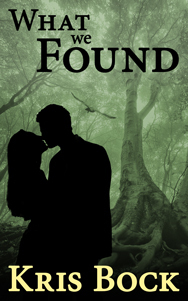 Counterfeits – Jenny returns to her grandparents’ art camp in a remote New Mexico town after her grandmother’s sudden death. That night, staying alone in the empty house, she wakes to the noise of intruders. What do the strangers want? As more bizarre events unfold, Jenny starts to realize the people she thought she knew are not what they seem – least of all Rob, an old friend and the camp cook, whose past may be coming back to haunt them all.
Counterfeits – Jenny returns to her grandparents’ art camp in a remote New Mexico town after her grandmother’s sudden death. That night, staying alone in the empty house, she wakes to the noise of intruders. What do the strangers want? As more bizarre events unfold, Jenny starts to realize the people she thought she knew are not what they seem – least of all Rob, an old friend and the camp cook, whose past may be coming back to haunt them all.What We Found – When Audra stumbles on a murdered woman in the woods, more than one person isn’t happy about her bringing the crime to light. She’ll have to stand up for herself in order to stand up for the murder victim. It’s a risk, and so is reaching out to the mysterious young man who works with deadly birds of prey. But with danger all around, some risks are worth taking.
Whispers in the Dark – Kylie Hafford craves adventure when she heads to the remote Puebloan ruins of Lost Valley, Colorado, to excavate. Romance isn’t in her plans, but she soon meets two sexy men: Danesh looks like a warrior from the Pueblo’s ancient past, and Sean is a charming, playful tourist. The summer heats up as Kylie uncovers mysteries, secrets, and terrors in the night. She’ll need all her strength and wits to survive—and to save the man she’s come to love.
Read excerpts at www.krisbock.com or visit the Kris Bock Amazon page. Sign up for the Kris Bock newsletter for announcements of new books, sales, and more.
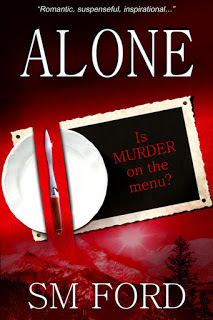 Inspirational
InspirationalIf you prefer an inspirational title, try Alone, a romantic suspense, by SM Ford:
Ready for adventure in the snowy Colorado mountains, Cecelia Gage is thrilled to be employed as the live-in housekeeper for her favorite bestselling author. The twenty-five-year-old doesn’t count on Mark Andrews being so prickly, nor becoming part of the small town gossip centering on the celebrity. Neither does she expect to become involved in Andrews family drama and a relationship with Simon Lindley, Mark’s oh so good-looking best friend. And certainly, Cecelia has no idea she’ll be mixed up in a murder investigation because of this job.Will Cecelia’s faith in God get her through all the trouble that lies ahead?
Visit SM Ford’s website or find her on Amazon.
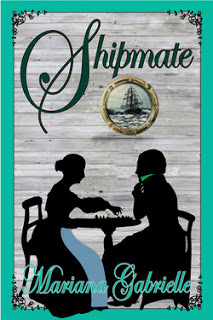 Historical
HistoricalIf you’d like to journey to the past, try one of the historical romance novels from Mariana Gabrielle. You can check out her writing with the free prequel novella Shipmate:
The heavy hands and sharp tongues of Bella Smithson’s family have left her almost too timid to converse with a gentleman, much less conduct a husband hunt. Unfortunately, her overbearing aunt and managing cousin are determined to help her escape her black-hearted father and brothers.
Thanks to the Prince of Wales, retiring shipping magnate Myron Clewes has an ever-growing fortune, a fresh-minted peerage, a brand-new flagship, and an impossible set of requirements for a bride. Not least, she must be willing to leave England and everything she knows, possibly for good, in less than two months’ time.
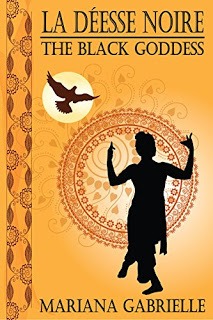 Or for something different, try La Déesse Noire: The Black Goddess:
Or for something different, try La Déesse Noire: The Black Goddess:Kali Matai, London’s most famed Indian dancer and courtesan, harbors a lifetime of secrets, as more lives than hers depend on it.
Sired by a British peer, born of a paramour to Indian royalty, she has been destined from birth to enthrall England’s most powerful noblemen—though she hadn’t counted on becoming their pawn. Finding herself under the control of ruthless men, who will not be moved by her legendary allure, she has no choice but to use her beauty toward their malicious and clandestine ends.
When those she holds most dear are placed in peril by backroom political dealings, she enlists some of the most formidable lords in England to thwart her enemies. But even with the help of the prominent gentlemen she has captivated, securing Kali’s freedom, her family, and the man she loves, will require her protectors stop at nothing to fulfill her desires.
check out her Amazon page.
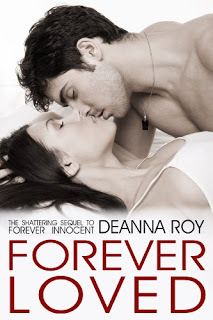 If you prefer contemporary romances, check out Deanna Roy’s Forever Innocent series:
If you prefer contemporary romances, check out Deanna Roy’s Forever Innocent series:Corabelle doesn’t feel like any of the other college girls. On what should have been one of the happiest nights of her life, she and her boyfriend Gavin watched a nurse disconnect the ventilator from their seven-day-old baby. During the funeral two days later, Gavin walked out and never returned.
Since then, her life has been a spiral of disasters. The only thing that has helped is her ability to black out whenever the pain gets too hard to bear, a habit that has become an addiction.
When Gavin shows up in her astronomy class four years later, he is hell-bent on getting her back, insisting she forgive him. Corabelle knows she can’t resist the touch that fills the empty ache that has haunted her since he left. But if he learns what she has done, if he follows the trail back through her past, her secrets will destroy their love completely. And once again, she’ll lose the only person who always believed she was innocent.
A New Adult Contemporary Romance
Visit Deanna’s website or Amazon page.
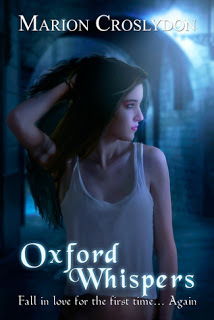 Prefer a bit of paranormal in your Romance? Check out Marion Croslydon’s titles.
Prefer a bit of paranormal in your Romance? Check out Marion Croslydon’s titles.Oxford Whispers
Madison LeBon is dead set against the dead.
Her fresh start at Oxford University is a brand new beginning. She finally has a chance to turn the page on her psychic powers and cumbersome voodoo heritage. Snakes, dolls, ghosts, and spirits: Farewell…Not quite.When the tragic lovers in a painting—the subject of her first history class—begin to haunt her, she must accept her gift before life imitates art. The lovers warn her against their own nemesis, a Puritan from the English Civil War. Unfortunately, said nemesis is now going all homicidal on Madison.College becomes more complicated when she falls hard for Rupert Vance, a troubled aristocrat and descendant of one of the characters in the painting. With the spirit of a murderer after her, Madison realizes that her own first love may also be doomed…
To learn about this and her other books, visit Marion’s website or Amazon page.
Published on November 23, 2016 05:00
November 22, 2016
#Holiday Gift Guide: Picture Books for Children #KidLit
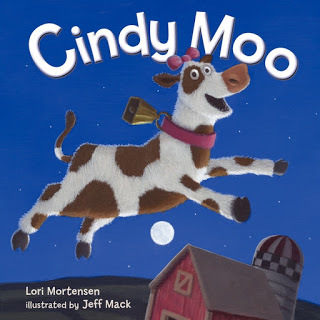 Picture Books for Young Children
Picture Books for Young ChildrenIf you have young readers – or pre-readers – on your shopping list, consider some of these adorable picture books from Lori Mortensen:
Cindy MooOne night on the farm, the cows overhear a fantastic tale. “Hey Diddle Diddle, the cat and the fiddle, the cow jumped over the moon!” Inspired by this classic rhyme, a plucky cow named Cindy Moo sets out to prove that cows really can leap over the moon. The other cows laugh, but that doesn’t stop Cindy Moo from trying night after night. Could a cow really jump over the moon? This delightfully silly picture book will have readers of all ages cheering for its determined heroine.
Cowpoke Clyde and Dirty Dawg What’s Cowpoke Clyde to do with Dawg, covered in mud and not smellin’ so sweet? Pop him in the tub of course! But Dawg will have none of it, setting off a commotion that has all the critters on the ranch dashing every which way to stay out of range. It’s not till Clyde is ready to throw in the towel, that he discovers the secret to bathing Dawg. Rollicking verse with page-turn surprises makes this uproarious tall tale a rootin’ tootin’ read-aloud.
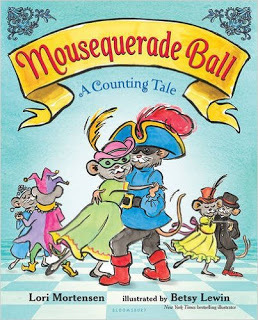 Cowpoke Clyde Rides the RangeCowpoke Clyde learns to ride a bike in a story of perseverance and friendship, with plenty of Western flair and a big dollop of humor.
Cowpoke Clyde Rides the RangeCowpoke Clyde learns to ride a bike in a story of perseverance and friendship, with plenty of Western flair and a big dollop of humor.Mousequerade BallCounting up to ten and back again, dancing all the while, this delightful story invites readers--and dancers--to the event of the season: The Mousequerade Ball!
Chicken LilyChicken Lily may be a lot of things--a careful colorer, a patient puzzler, and a quiet hide-and-seeker (she never makes a peep!)--but brave is not one of them. When her teacher, Mrs. Lop, plans a school-wide poetry jam, Lily is terrified. She doesn’t want to stand in front of everyone and sound like a bird brain! With encouragement from her friends Baabette and Pigsley, Lily decides to hatch a plan. Can she put her best claw forward and prove that even chickens aren’t chicken all the time?
Check out all her titles on Amazon.
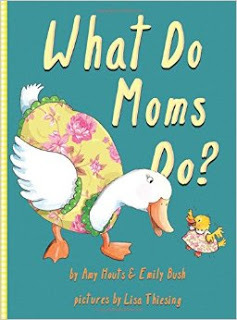 Or here’s a fun picture book from Amy Houts:
Or here’s a fun picture book from Amy Houts:What Do Moms Do? In this picture book, charming illustrations by award-winning artist, Lisa Thiesing, tell the story of a newly-hatched duckling who asks her friends, “What do moms do?” Using humor in everyday situations, animals describe how mothers show their love. Perfect for bedtime or anytime a soothing story is desired. Available in paper book or as an ebook for $2.99.
See all of Amy Hout’s books at her website or on Amazon.
Do you want to share some nature nonfiction instead? Here’s another title from Lori Mortensen:
In the Trees, Honey Bees! Peek inside this tree and see a wild colony of honey bees. It hums with life. Look at the thousands of worker bees--each one doing her job. Some are making wax. Some are feeding the hungry brood. Some are storing sweet honey. Look at all the combs, filled with honey and pollen! And there’s the queen, laying eggs. It’s all very organized, like a smoothly running town. A honey bee colony is a remarkable place, and you will never look at bees in the same way again
Find it on Amazon.
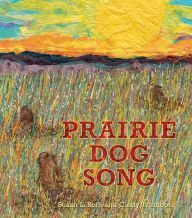 Or try this one from Cindy Trumbore:
Or try this one from Cindy Trumbore:Prairie Dog Song, co-written with and illustrated by collage artist Susan L. Roth, has received three starred reviews and was a Junior Library Guild selection. Aimed at children in grades 1-4, it tells the history of the prairie dog and its role as a key species in the North American grasslands ecosystem. The text is a combination of a song to the tune of “The Green Grass Grew All Around,” with fact boxes giving more information about each spread. The music is at the back of the book and is available as a free download from the publisher’s website.
Find this title at Amazon or learn more about Cindy’s books at her website.
Finally, the following is Fun for All Ages!
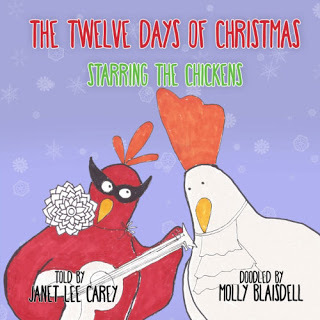 The Twelve Days of Christmas: Starring The Chickens
The Twelve Days of Christmas: Starring The Chickens Chickens peck. Chickens peep. Chickens do not take over Halloween. Or do they? In this world upside-down story for all chicken lovers, silliness and a clucking good time leads to a surprise. (The Chickens previously starred in Chickens Do Not Take Over Halloween.)
Visit Molly’s websiteor her see all her books at Amazon.
See my posts on books for middle grade children and teenagers from yesterday. I’ll be posting some titles for grown-ups tomorrow.
Published on November 22, 2016 05:30
November 21, 2016
#Holiday Gift Guide – Great Books for Middle Grade and Teen Readers
 Fun Books for Middle Grade Readers
Fun Books for Middle Grade ReadersOh the weather outside is… not that bad here, actually, but it’s still feeling like the holiday season is in full swing. If you have a young reader on your shopping list, consider one of these titles from Chris Eboch, appropriate for ages 8 to 15.
The Genie’s Gift is a lighthearted action novel set in the fifteenth-century Middle East, drawing on the mythology of The Arabian Nights. Shy and timid Anise determines to find the Genie Shakayak and claim the Gift of Sweet Speech. But the way is barred by a series of challenges, both ordinary and magical. How will Anise get past a vicious she-ghoul, a sorceress who turns people to stone, and mysterious sea monsters, when she can’t even speak in front of strangers?
 In The Well of Sacrifice, a Mayan girl in ninth-century Guatemala rebels against the High Priest who sacrifices anyone challenging his power.
In The Well of Sacrifice, a Mayan girl in ninth-century Guatemala rebels against the High Priest who sacrifices anyone challenging his power. Kirkus Reviews called The Well of Sacrifice, “[An] engrossing first novel….Eboch crafts an exciting narrative with a richly textured depiction of ancient Mayan society….The novel shines not only for a faithful recreation of an unfamiliar, ancient world, but also for the introduction of a brave, likable and determined heroine.”
Watching this unorthodox 12-year-old girl outwit a high priest, escape jail, rescue her sister and more makes for a fast-paced read. An author’s note describes the historical context for the tale. - Publishers Weekly
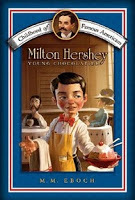 Jesse Owens: Young Record Breaker and Milton Hershey: Young Chocolatier are inspirational biographies in Simon & Schuster’s Childhood of Famous Americans series, written under the name M.M. Eboch.
Jesse Owens: Young Record Breaker and Milton Hershey: Young Chocolatier are inspirational biographies in Simon & Schuster’s Childhood of Famous Americans series, written under the name M.M. Eboch. Jesse Owens would be especially suitable for young athletes, while Milton Hershey might appeal to kids who struggle in school, as Milton did. They are full-length books at a middle grade interest level, but written at a third-grade reading level.
See these and more at www.chriseboch.com or her Amazon page.
More Books for Middle Grade Readers
 The Cousins in Action Series by Sam Bond
The Cousins in Action Series by Sam BondOperation Golden Llama, by Sam Bond
Dumped at their eccentric Grandma’s, Cagney, Olivia, Aidan, Lissy and Tess are convinced they’re in for a boring summer. But when Grandma gets a series of mysterious phone calls, and a highly unlikely pet sitter arrives, the cousins find themselves jetting off to Peru, where much to their surprise they find their adventures have only just begun.
Visit Sam Bond’s website or her Amazon page.
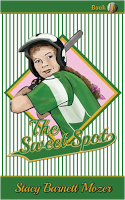 The Sweet Spot, by Stacy Barnett Mozer
The Sweet Spot, by Stacy Barnett MozerWhen thirteen-year-old Sam Barrette’s baseball coach tells her that her attitude’s holding her back, she wants to hit him in the head with a line drive. All stakes now rest on Sam’s performance at baseball training camp. Placed at the bottom with the weaker players, she will have to work her way up to A league, not just to show Coach that she can be the best team player possible, but to prove to herself that she can hold a bat with the All-Star boys.
Visit Stacy Barnett Mozer’s website or her Amazon page.
Fantasy Set Today
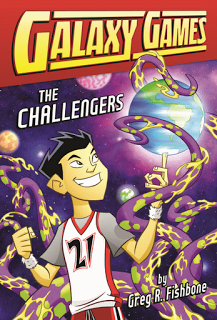 The Galaxy Games Series by Greg Fishbone:
The Galaxy Games Series by Greg Fishbone:The Challengers
Things are looking up for Tyler Sato (literally!) as he and his friends scan the night sky for a star named for him by his Tokyo cousins in honor of his eleventh birthday. Ordinary stars tend to stay in one place, but Ty’s seems to be streaking directly toward Earth at an alarming rate. Soon the whole world is talking about TY SATO, the doomsday asteroid, and life is turned upside down for Ty Sato, the boy, who would rather be playing hoops in his best friend’s driveway….
The Amorphous Assassin
Thirteen-year-old Tyler Sato has lied, cheated, and scammed his way into the Galaxy Games. Now, on the eve of the galaxy-spanning sports tournament, Tyler’s past is catching up…with a vengeance!Earth’s team of international all-stars is at each other’s throats. A shadowy conspiracy is on the move. And a shape-shifting alien assassin has Tyler in his sights.
Can Tyler step up his game to become the leader Earth needs? Or will the world finally discover that Tyler isn’t quite the hero that everyone believes?
Visit Greg Fishbone’s website or his Amazon page.
The Magic Mayhem Series by Deanna Roy
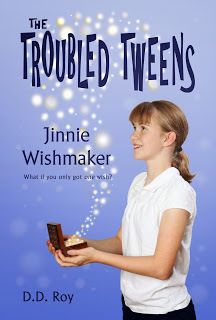 Jinnie Wishmaker
Jinnie WishmakerSix-time USA Today bestselling author Deanna Roy mixes adventure and magic in her first series for middle grade readers. In Jinnie Wishmaker, an eleven-year-old girl discovers she can grant any living thing its one true wish. The trouble is, once she grants the wish, she can’t control the results.
Marcus Mender
Marcus Mender can fix anything just by holding it. But now, he can't stop! Like King Midas and the golden touch, everything becomes new and perfect in Marcus's hands.
Before he can control his new power, the magical Vor team is sent to South America on a mission: to recover a rare magnetized lodestone before the Loki, the magic thieves, use it for their own selfish purpose.
But the lodestone's magnetic field causes a reversal between positive and negative, turning the Loki into heroes and the Vor into villains out to steal more power. Only Marcus's ability to fix the lodestone can save them, but with the switch of good and evil, Marcus will have to fight his own magic to make the right choice.
Marcus Mender is Book 2 of the Magic Mayhem series that begins with Jinnie Wishmaker. However, it can be read as a standalone book and is aimed at reluctant readers.
Visit Deanna Roy’s blog or find Jinnie and Marcus on Amazon page.
For Teens and up
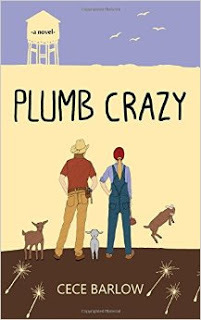 For a fun romp with a lot of heart, suitable for teenagers or adults, check out Plum Crazy by Cece Barlow:
For a fun romp with a lot of heart, suitable for teenagers or adults, check out Plum Crazy by Cece Barlow:The summer of her junior year, Texas geek girl Elva Presley Hicks lands a job as a plumber’s helper in Houston, Texas. She earns $$$$, but is as lonely as heck.
It’s not like there aren’t any suitors. Elva could choose Chase, the obese pig farmer, or Wyatt, the plumber with wandering hands, but she yearns for something more and finds it with electrician, Mitch McCall.
It’s a cosmic connection. Mitch isn’t turned off by Elva’s name or fan fiction writing, and Elva doesn’t lose interest in him after he cuts off his nose.
Trials and triumphs follow Elva, including a friendship implosion, world-wide fanfic humiliation, and goat salvation.
This summer is destined to be Elva’s most memorable. Join her!
Visit Cece Barlow’s Amazon page.
Tomorrow I'll post some picture books for younger children. On Friday, I'll list some titles for grown-ups.
Published on November 21, 2016 08:02
#PiBoIdMo - Developing Your Picture Book Ideas
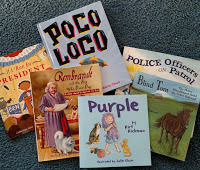 Last week, I discussed Finding the Seeds of Stories for Picture Book Idea Month (PiBoIdMo). It's fine if you think up quick, basic ideas that need a lot of development – you’ve still met the challenge! But maybe you want to spend a little more time developing your idea now. Or you could bookmark this post or print it out to use later, when you go back to your favorite ideas and develop them.
Last week, I discussed Finding the Seeds of Stories for Picture Book Idea Month (PiBoIdMo). It's fine if you think up quick, basic ideas that need a lot of development – you’ve still met the challenge! But maybe you want to spend a little more time developing your idea now. Or you could bookmark this post or print it out to use later, when you go back to your favorite ideas and develop them.(The following is excerpted from You Can Write for Children : How to Write Great Stories, Articles, and Books for Kids and Teenagers. The bookis available for the Kindle, in paperback, or in Large Print paperback. That book and A dvanced Plotting will provide lots of help as you write and edit.)
Developing an Idea
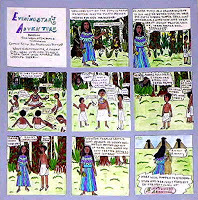 Once you have your idea, it’s time to develop it into a story or novel. Of course, you can simply start writing and see what happens. Sometimes that’s the best way to explore an idea and see which you want to say about it. But you might save time – and frustration – by thinking about the story in advance. You don’t have to develop a formal, detailed outline, but a few ideas about what you want to say, and where you want the story to go, can help give you direction.
Once you have your idea, it’s time to develop it into a story or novel. Of course, you can simply start writing and see what happens. Sometimes that’s the best way to explore an idea and see which you want to say about it. But you might save time – and frustration – by thinking about the story in advance. You don’t have to develop a formal, detailed outline, but a few ideas about what you want to say, and where you want the story to go, can help give you direction. You can look at story structure in several ways. Here’s one example of the parts of a story or article:
· A catchy title. The best titles hint at the genre or subject matter.
· A dramatic beginning, with a hook. A good beginning:
– grabs the reader’s attention with action, dialogue, or a hint of drama to come
– sets the scene
– indicates the genre and tone (in fiction) or the article type (in nonfiction)
– has an appealing style
· A solid middle, which moves the story forward or fulfills the goal of the article.
Fiction should focus on a plot that builds to a climax, with character development. Ideally the character changes by learning the lesson of the story.
Nonfiction should focus on information directly related to the main topic. It should be organized in a logical way, with transitions between subtopics. The tone should be friendly and lively, not lecturing. Unfamiliar words should be defined within the text, or in a sidebar.
· A satisfying ending that wraps up the story or closes the article. Endings may circle back to the beginning, repeating an idea or scene, but showing change. The message should be clear here, but not preachy. What did the character learn?
· Bonus material: An article, short story, or picture book may use sidebars, crafts, recipes, photos, etc. to provide more value. For nonfiction, include a bibliography with several reliable sources.
Take a look at one of your PiBoIdMo ideas. Can you start developing it by thinking about story structure in this way?
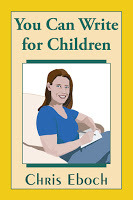 You Can Write for Children
: How to Write Great Stories, Articles, and Books for Kids and Teenagers is available for the Kindle, in paperback, or in Large Print paperback.
You Can Write for Children
: How to Write Great Stories, Articles, and Books for Kids and Teenagers is available for the Kindle, in paperback, or in Large Print paperback. AdvancedPlotting is available in print or ebook at Amazon and Barnes & Noble, or in various ebook formats at Smashwords.
Published on November 21, 2016 06:00
October 31, 2016
#PiBoIdMo - Finding the Seeds of Stories
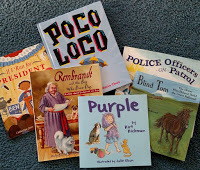 November is Picture Book Idea Month (PiBoIdMo). The goal is to come up with a new picture book idea every day. Impossible? You'll find lots of idea starters and writing prompts on the PiBoIdMosite and elsewhere.
November is Picture Book Idea Month (PiBoIdMo). The goal is to come up with a new picture book idea every day. Impossible? You'll find lots of idea starters and writing prompts on the PiBoIdMosite and elsewhere.Here are some more options for brainstorming ideas. (The following is excerpted from You Can Write for Children : How to Write Great Stories, Articles, and Books for Kids and Teenagers. The bookis available for the Kindle, in paperback, or in Large Print paperback. That book and A dvanced Plotting will provide lots of help as you write and edit.)
Take some time to relax and think about each question. Delve deep into your memories. Take lots of notes, even if you’re not sure yet whether you want to pursue an idea. You can put each idea on a separate index card, or fill a notebook, or start a file folder with scraps of paper. Do whatever works for you.
Find story and article ideas based on your childhood experiences, fears, dreams, etc.:
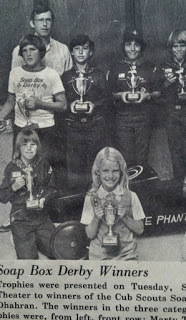 · What’s the scariest thing that happened to you as a child? The most exciting? The funniest?
· What’s the scariest thing that happened to you as a child? The most exciting? The funniest?· What’s the most fun you ever had as a child? What were your favorite activities?
· What was the hardest thing you had to do as a child?
· What interested you as a child?
· When you were a child, what did you wish would happen?
Find story and article ideas based on the experiences of your children, grandchildren, students, or other young people you know:
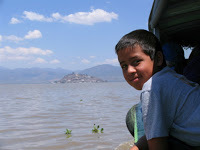 · What interests them?
· What interests them?· What frightens them?
· What do they enjoy?
· What challenges do they face?
· What do their lives involve – school, sports, family, religion, clubs?
Other questions to consider:
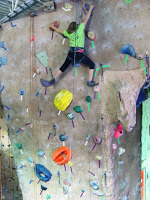 What hobbies or interests do you have that might interest children?
What hobbies or interests do you have that might interest children? What jobs or experiences have you had that could be a good starting point for an nonfiction book or story?
Do you know about other cultures, or a particular time period?
What genres do you like? Would it be fun to write in that genre?
 What genres did you like as a child? Did you love mysteries, ghost stories, fantasies, or science fiction? What were your favorite books? Why?
What genres did you like as a child? Did you love mysteries, ghost stories, fantasies, or science fiction? What were your favorite books? Why?Look for inspiration in other stories, books, or TV shows. Can you take the premise and write a completely different story? Do you want to write something similar (a clever mystery, a holiday story, or whatever)? Do you want to retell a folktale or fable as a modern version, or with a cultural twist?
What do you see in the news? Is there a timely topic that could make a good article? If you read about kids doing something special, could you turn it into a profile for a children’s magazine? (This wouldn't work as well for a picture book, but I’m being flexible with the concept here.)
How might that news story work as fiction? Could you base a short story or novel on a true story about someone surviving danger or overcoming great odds?
Even the phonebook can provide inspiration. Check the Yellow Pages: Could you interview an automotive painter, animal trainer, or architect for a nonfiction book? What would life be like for a child to have parents in that field?
Wherever you look for ideas, search for things that are scary, exciting or funny – strong emotion makes a strong story.
Don’t preach. Kids don’t want to read about children learning lessons. All stories have themes, but when someone asks you about a mystery you read, you’re probably not going to say, “It was a story about how crime doesn’t pay.” Rather, you’ll talk about the exciting plot, the fascinating characters, perhaps even the unusual setting. A story’s message should be subtle.
Now start brainstorming and have fun!
 You Can Write for Children
: How to Write Great Stories, Articles, and Books for Kids and Teenagers is available for the Kindle, in paperback, or in Large Print paperback.
You Can Write for Children
: How to Write Great Stories, Articles, and Books for Kids and Teenagers is available for the Kindle, in paperback, or in Large Print paperback. AdvancedPlotting is available in print or ebook at Amazon and Barnes & Noble, or in various ebook formats at Smashwords.
Published on October 31, 2016 06:00
October 24, 2016
Getting Ready for #NaNoWriMo and #PiBoIdMo
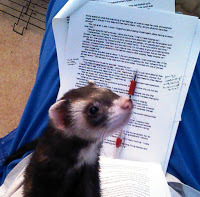 During National Novel Writing Month (NaNoWriMo), thousands of people work on writing a rough draft of a novel in a month of November. For those of you who write for younger children, November is also Picture Book Idea Month (PiBoIdMo). There the goal is to come up with a new picture book idea every day. These challenges may sound intimidating, but they are widely popular.
During National Novel Writing Month (NaNoWriMo), thousands of people work on writing a rough draft of a novel in a month of November. For those of you who write for younger children, November is also Picture Book Idea Month (PiBoIdMo). There the goal is to come up with a new picture book idea every day. These challenges may sound intimidating, but they are widely popular.Why? Well, taking on an intensive challenge for a month has several advantages. The most obvious is that it very quickly gives you material to develop. You can get a jump start on a new novel, or brainstorm a few dozen picture books ideas to pursue (though not all will be worth developing).
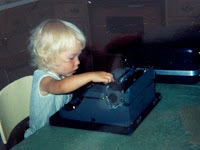 The time pressure forces you to put aside your editor and critic hats and instead focus on getting words on paper. This helps some people avoid the insecurity that can come with starting a new project, or the temptation to endlessly edit the first few chapters instead of moving forward. For picture book writers, having a lot of new ideas allows you to choose the best one, so you don’t waste time on a mediocre idea.
The time pressure forces you to put aside your editor and critic hats and instead focus on getting words on paper. This helps some people avoid the insecurity that can come with starting a new project, or the temptation to endlessly edit the first few chapters instead of moving forward. For picture book writers, having a lot of new ideas allows you to choose the best one, so you don’t waste time on a mediocre idea.It encourages you to schedule writing time – plenty of it, every week. It’s easier to give up TV, reading, and other hobbies for a single month. It’s also easier to get family members to adjust their schedule to yours if you are requesting a favor for a month, not forever. (You may even discover that your family, and the world, can function with less of your attention than you thought. Even if you can’t devote the same amount of time to writing after November, maybe you can carve out some time every week.)
Finally, both challenges have a strong sense of community. You can network with other writers, encourage each other, and find inspiring blog posts or helpful tips to keep you moving for your project.
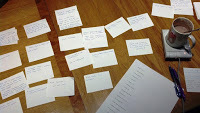 Are You in?
Are You in?If you want to be ready to write a novel in November, it’s best to start brainstorming and planning in advance. My next few posts will discuss finding and developing ideas. In November I'll have a couple of posts on PiBoIdMo. For NaNo writers, you can bookmark this site and stop by to check out the writing tips on everything from developing characters to building to a strong climax. (Scroll down to see the labels on the right-hand side.) Then check back in March for editing tips during National Novel Editing Month (NaNoEdMo).
The following is excerpted from You Can Write for Children : How to Write Great Stories, Articles, and Books for Kids and Teenagers. The bookis available for the Kindle, in paperback, or in Large Print paperback. That book and A dvanced Plotting will provide lots of help as you write and edit.
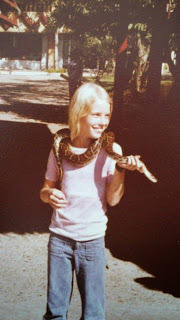 Finding Ideas
Finding IdeasIdeas are everywhere, including in our own lives. Of course, even the most exciting events may lack important story qualities such as character growth and strong plots. (Those qualities are covered in detail in You Can Write for Children .) Still, personal and family experiences can provide the raw material to be molded into publishable stories and articles.
Amy Houts wrote Down on the Farm, about a girl on a farm vacation who wants to ride a horse but must do chores first. Houts was inspired by her own experiences, though not by a specific episode. “I was one of those horse-crazy girls,” she says. “I knew how a girl could long to ride a horse.”
Sometimes the smallest nugget can inspire a story. Susan Uhlig says, “My teen daughters and friends went on a mission trip to do a building project. The man overseeing the project was disappointed that there were no boys. I played the writer game of ‘what if?’ What if the man wouldn’t let the team stay because they were all girls? That developed into a short story very easily – what he would say, my main character girl would do, how the problem would be solved, etc.” The story sold to Brio.
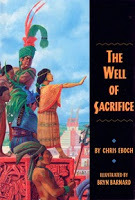 Personally, I sold a story to Highlights based on the experience of finding frogs all over my neighborhood after a rainstorm. They also bought a historical story about the Mayan ballgame. That story, and my Mayan historical novel The Well of Sacrifice, were inspired by visiting Mayan ruins in Mexico and Central America.
Personally, I sold a story to Highlights based on the experience of finding frogs all over my neighborhood after a rainstorm. They also bought a historical story about the Mayan ballgame. That story, and my Mayan historical novel The Well of Sacrifice, were inspired by visiting Mayan ruins in Mexico and Central America.Realistic, Not Real
 Sometimes real life translates well into fiction – though a twist may make it more fun for children. Leslie Helakoski says, “My picture book, Big Chickens, is about all the things I was afraid of when young and I’d go into the woods with my brothers and sisters. I just turned us all into chickens and played with the language.”
Sometimes real life translates well into fiction – though a twist may make it more fun for children. Leslie Helakoski says, “My picture book, Big Chickens, is about all the things I was afraid of when young and I’d go into the woods with my brothers and sisters. I just turned us all into chickens and played with the language.” Caroline Hatton drew on school and home memories of growing up in Paris for her middle-grade novel, Véro and Philippe. Yet she did not simply write a memoir. “I wanted to write about a pet snail because I kept one in a shoebox in my family’s apartment in Paris. But in my real life, my big brother left me and my pet snail alone – not much of a story, is it? So in the book, I made the brother threaten to eat the snail, as escargot.”
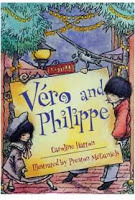 Characters and outcomes may also change, Hatton points out. “My brother rigged a thing to scare me in the middle of the night. But in the book, I swapped roles, and it’s the little sister who does it to her big brother. Sharing this with kids makes them howl with the pleasure of revenge.”
Characters and outcomes may also change, Hatton points out. “My brother rigged a thing to scare me in the middle of the night. But in the book, I swapped roles, and it’s the little sister who does it to her big brother. Sharing this with kids makes them howl with the pleasure of revenge.”Houts adds, “Most of the time I have to twist the reality of an experience so my story can include all the elements of good storytelling: a contrast of characters; a goal the main character strongly desires to reach; and believable obstacles the main character needs to overcome to reach her goal. Time needs to be cut down to a day or two [for a picture book]. That condenses the action and makes the story more focused.”
Author Renee Heiss says, “Use your life story as the skeleton, and then flesh it out with period details, colorful dialogue, and tons of sensory imagery to place your young readers into the time period and setting. It’s not enough to tell what happened; you must show your readers your story and immerse them into your life as if they were a sibling growing up with you.”
Asking friends and family members to share stories can provide ideas, while allowing you to turn the story into your own creation. Uhlig didn’t witness the mission trip firsthand. “That freed me up to create problem, action, dialogue, etc. without being stuck on what really happened,” she says.
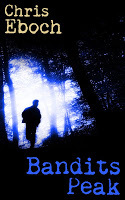 You can “borrow” stories from history and the news as well. I found an interesting tidbit in a history of Washington State. A teenage boy had met bank robbers in the woods, and for some reason he told nobody about them. Why? This question, and my imagined answers to it, became my YA survival suspense Bandits Peak.
You can “borrow” stories from history and the news as well. I found an interesting tidbit in a history of Washington State. A teenage boy had met bank robbers in the woods, and for some reason he told nobody about them. Why? This question, and my imagined answers to it, became my YA survival suspense Bandits Peak. You Can Write for Children
: How to Write Great Stories, Articles, and Books for Kids and Teenagers is available for the Kindle, in paperback, or in Large Print paperback.
You Can Write for Children
: How to Write Great Stories, Articles, and Books for Kids and Teenagers is available for the Kindle, in paperback, or in Large Print paperback. AdvancedPlotting is available in print or ebook at Amazon and Barnes & Noble, or in various ebook formats at Smashwords.
Published on October 24, 2016 06:56
October 17, 2016
#NaNoWriMo and #PiBoIdMo - Developing Your Idea
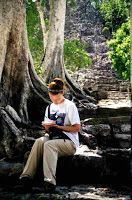 Last week, I discussed National Novel Writing Month (NaNoWriMo) and Picture Book Idea Month (PiBoIdMo), both of which take place over the month of November. If you plan to participate, it helps to do some prep!
Last week, I discussed National Novel Writing Month (NaNoWriMo) and Picture Book Idea Month (PiBoIdMo), both of which take place over the month of November. If you plan to participate, it helps to do some prep!Here are some tips for developing your idea. (If you are doing NaNoWriMo, try to do this before you start writing in November. For PiBoIdMo, bookmark this post or print it out so you can use it as you brainstorm ideas next month.)
(The following is excerpted from You Can Write for Children : How to Write Great Stories, Articles, and Books for Kids and Teenagers. The bookis available for the Kindle, in paperback, or in Large Print paperback. That book and A dvanced Plotting will provide lots of help as you write and edit.)
Developing an Idea
 If you have a “great idea,” but can’t seem to go anywhere with it, you probably have a premise rather than a complete story plan. A story should have three parts: beginning, middle, and end (plus title and possibly bonus material). This can be a bit confusing though. Doesn’t every story have a beginning, middle, and end? It has to start somewhere and end at some point, and other stuff is in the middle. Beginning, middle, and end!
If you have a “great idea,” but can’t seem to go anywhere with it, you probably have a premise rather than a complete story plan. A story should have three parts: beginning, middle, and end (plus title and possibly bonus material). This can be a bit confusing though. Doesn’t every story have a beginning, middle, and end? It has to start somewhere and end at some point, and other stuff is in the middle. Beginning, middle, and end!Technically, yes, but certain things should happen at those points.
1. The beginning introduces a character with a problem or a goal.
2. During the middle of the story, that character tries to solve the problem or reach the goal. He probably fails a few times and has to try something else. Or he may make progress through several steps along the way. He should not solve the problem on the first try, however.
3. At the end, the main character solves the problem himself or reaches his goal through his own efforts.
You may find exceptions to these standard story rules, but it’s best to stick with the basics until you know and understand them. They are standard because they work!
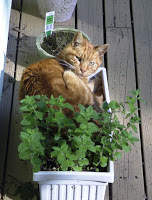 Cute, but no conflictTeachers working with beginning writers often see stories with no conflict – no problem or goal. The story is more of a “slice of life.” Things may happen, possibly even sweet or funny things, but the story does not seem to have a clear beginning, middle, and end; it lacks structure. Without conflict, the story is not that interesting.
Cute, but no conflictTeachers working with beginning writers often see stories with no conflict – no problem or goal. The story is more of a “slice of life.” Things may happen, possibly even sweet or funny things, but the story does not seem to have a clear beginning, middle, and end; it lacks structure. Without conflict, the story is not that interesting.You can have two basic types of conflict. An external conflict is something in the physical world. It could be a problem with another person, such as a bully at school, an annoying sibling, a criminal, or a fantastical being such as a troll or demon. External conflict would also include problems such as needing to travel a long distance in bad weather.
The other type of conflict is internal. This could be anything from fear of the dark to selfishness. It’s a problem within the main character that she has to overcome or come to terms with.
An internal conflict is often expressed in an external way. If a child is afraid of the dark, we need to see that fear in action. If she’s selfish, we need to see how selfishness is causing her problems. Note that the problems need to affect the child, not simply the adults around her. If a parent is annoyed or frustrated by a child’s behavior, that’s the parent’s problem, not the child’s. The child’s goal may be the opposite of the parent’s; the child may want to stay the same, while the parent wants the child to change.
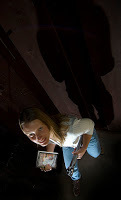 For stories with internal conflict, the main character may or may not solve the external problem. The child who is afraid of the dark might get over that fear, or she might learn to live with it by keeping a flashlight by her bed. The child who is selfish and doesn’t want to share his toys might fail to achieve that goal. Instead, he might learn the benefits of sharing.
For stories with internal conflict, the main character may or may not solve the external problem. The child who is afraid of the dark might get over that fear, or she might learn to live with it by keeping a flashlight by her bed. The child who is selfish and doesn’t want to share his toys might fail to achieve that goal. Instead, he might learn the benefits of sharing.However the problem is resolved, remember that the child main character should drive the solution. No adults stepping in to solve the problem! In the case where a child and a parent have different goals, it won’t be satisfying to young readers if the parent “wins” by punishing the child. The child must see the benefit of changing and make a decision to do so.
A Story in Four Parts
If “beginning, middle, and end” doesn’t really help you, here’s another way to think of story structure. A story has four main parts: situation, complications, climax, andresolution. You need all of them to make your story work. (This is really the same as beginning, middle, and end, with the end broken into two parts, but the terms may be clearer.)
The situation should involve an interesting main character with a challenging problem or goal. Even this takes development. Maybe you have a great challenge, but aren’t sure why a character would have that goal. Or maybe your situation is interesting, but it doesn’t actually involve a problem.
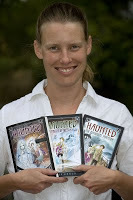 For example, I wanted to write about a brother and sister who travel with a ghost hunter TV show. The girl can see ghosts, but the boy can’t. That gave me the characters and situation, but no problem or goal. Goals come from need or desire. What did they want that could sustain a series?
For example, I wanted to write about a brother and sister who travel with a ghost hunter TV show. The girl can see ghosts, but the boy can’t. That gave me the characters and situation, but no problem or goal. Goals come from need or desire. What did they want that could sustain a series?Tania feels sorry for the ghosts and wants to help them, while keeping her gift a secret from everyone but her brother. Jon wants to help and protect his sister, but sometimes he feels overwhelmed by the responsibility. Now we have characters with problems and goals. The story is off to a good start. (This became the four-book Haunted series.)
Tips:
· Make sure your idea is specific and narrow. Focus on an individual person and situation, not a universal concept. For example, don’t try to write about “racism.” Instead, write about one character facing racism in a particular situation.
· The longer the story, the higher the stakes needed to sustain it. A short story character might want to win a contest; a novel character might need to save the world.
· Ask why the goal is important to the character. Why does this particular individual desperately want to succeed in this challenge?
· Ask why this goal is difficult. If reaching the goal is too easy, there is little tension and the story is too short. The goal should be possible, but just barely. It might even seem impossible. The reader should believe that the main character could fail.
· Even if your main problem is external, try giving the character an internal flaw that contributes to the difficulty. This adds complications and also makes your character seem more real. For some internal flaws, see the seven deadly sins: lust, gluttony, greed, sloth, wrath, envy, and pride.
· Test the idea. Change the character’s age, gender, or looks. Change the point of view, setting, external conflict, or internal conflict. Choose the combination that has the most dramatic potential.
 You Can Write for Children
: How to Write Great Stories, Articles, and Books for Kids and Teenagers is available for the Kindle, in paperback, or in Large Print paperback.
You Can Write for Children
: How to Write Great Stories, Articles, and Books for Kids and Teenagers is available for the Kindle, in paperback, or in Large Print paperback. AdvancedPlotting is available in print or ebook at Amazon and Barnes & Noble, or in various ebook formats at Smashwords.
Published on October 17, 2016 05:00
October 10, 2016
An Online Workshop: Writing Stories for Children #KidLit
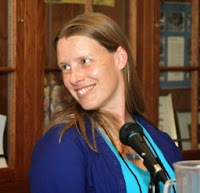 Starts Soon - Sigh Up Now!
Starts Soon - Sigh Up Now!You Can Write Stories for Childrena writing class with Chris Eboch
START DATE: Monday, October 17, 2016
DURATION:8 weeks (four classes)
WHERE: Online – work from home at your own pace
COURSE DESCRIPTION: Remember the magic of bedtime stories? When you write for children, you have the most appreciative audience in the world. But to reach that audience, you need to understand the business of writing for children, including the requirements for different genres, age ranges, and markets. You also need to write fresh, dynamic stories, whether you’re writing rhymed picture books or middle grade mysteries or edgy teen novels. In this hands-on workshop, we’ll explore how. You'll leave with a story in progress and ideas for future development.
Your enthusiasm is contagious, and the sheer amount of knowledge you possess is fantastic. Your advice was always spot on. The links to various articles and blogs was and will continue to be extremely useful.~ Nancy Partridge
I have to tell you that your workshop was the one I got the most useful information from. It was quite informative and introduced me to several trains of thought that were new to me. ~ Donna J. Barland
Thank you for putting together such a helpful workshop. Of the entire weekend, I think I learned the most from listening to you. Thanks again for such a great workshop. ~ Linda Reedy
Thanks for your terrific workshop yesterday at the SCBWI conference. I loved your thoughts on pacing, cliffhangers, etc. You certainly added to my positive experience! ~ Alyssa Kirk
Just a quick note to say thanks for your class this past weekend. Your class on Monday afternoon was my favorite. You gave us very specific things we could incorporate into our own work. That’s the kind of info I was looking for when I signed up for the conference. ~ Pamela Haskin
Chris is hands-down one of the best author-speakers we’ve ever had. I don’t think she uttered a word about her own life story as many do; she was all about teaching a vital and often forgotten aspect in our writing. The comments on her were full of grateful praise. ~ Robin Koontz, SCBWI Oregon retreat leader
WEEKS AT A GLANCE:
Week 1-2: The World of Writing for Children
We’ll start with an overview of the markets. These include books, magazines, and more. Learn the specific requirements when writing for different age ranges. This will help you decide where you feel comfortable – or give you many areas to explore!
Assignment 1: Read 5 to 10 picture books or stories for children or review two recent novels. Brainstorm 5 to 10 ideas using the material provided.
Week 3-4: From Idea to Story
Writing for children has many things in common with any good writing, and some things that are special. We’ll explore the essential elements of appealing to children. Participants will learn how to develop their ideas:
Identify a marketChoose a target ageMatch the story length and reading level to the target ageDevelop charactersCreate a plot with conflict and a three-part structureFocus on young characters who have control
Assignment 2: Choose one of your ideas and identify the appropriate target age group and several possible markets. Start developing your characters and planning a strong plot.
Week 5-6: Develop and Share Your Story
Share your story in progress (or a pitch/outline for a novel) and receive feedback from the instructor and the class.
Assignment 3: Pitch your story. Based on feedback, draft a complete picture book or short story, or plan a novel.
Week 7-8: The Next Steps
We’ll cover editing techniques, submitting your work, and your questions. Expect to leave this workshop with a story in progress, and a list of ideas for future development.
Assignment 4: If you choose, turn in your final story or novel outline. Develop a plan for next steps (finishing, editing, querying/submitting/self-publishing your work etc.).
COST: $99, which includes weekly assignments and individual feedback from the instructor. This class will be conducted through a Discussion Board, with the opportunity for students to ask questions and post homework samples.
BUY NOW : You Can Write Stories for Children! by Chris Eboch (8 weeks/4 classes, starting 10/17/2016) Limit: 15 students. Early registration is recommended.
 ABOUT THE INSTRUCTOR: Chris Eboch is the author of over 30 books for children. Her novel for ages nine and up include The Well of Sacrifice, a Mayan adventure; The Genie’s Gift, a middle eastern fantasy; and the Haunted series, about kids who travel with a ghost hunter TV show. Chris’s writing craft books include Advanced Plotting and You Can Write for Children: How to Write Great Stories, Articles, and Books for Kids and Teenagers. Learn more at www.chriseboch.com or check out her writing tips at her Write Like a Pro! blog: http://chriseboch.blogspot.com/.
ABOUT THE INSTRUCTOR: Chris Eboch is the author of over 30 books for children. Her novel for ages nine and up include The Well of Sacrifice, a Mayan adventure; The Genie’s Gift, a middle eastern fantasy; and the Haunted series, about kids who travel with a ghost hunter TV show. Chris’s writing craft books include Advanced Plotting and You Can Write for Children: How to Write Great Stories, Articles, and Books for Kids and Teenagers. Learn more at www.chriseboch.com or check out her writing tips at her Write Like a Pro! blog: http://chriseboch.blogspot.com/.Chris has her MA degree in Professional Writing and Publishing from Emerson College in Boston. She taught through the Institute of Children’s Literature for 10 years and has led dozens of popular writing workshops around the world.
Chris also writes for adults under the name Kris Bock. “Kris Bock” novels are action-packed romantic suspense involving outdoor adventures and Southwestern landscapes. Read excerpts at www.krisbock.com.
Published on October 10, 2016 05:00
September 30, 2016
#Free Romantic Suspense Novel
 The Mad Monk's Treasure
is Free for the Kindle September 30 to October 2
The Mad Monk's Treasure
is Free for the Kindle September 30 to October 2“The action never stopped .... It was adventure and romance at its best.”
“I couldn’t put this book down. You’ll love it.”
Ordinary Women, Extraordinary Adventures
A legendary treasure hunt in the dramatic—and deadly—New Mexico desert....
The lost Victorio Peak treasure is the stuff of legends—a heretic Spanish priest’s gold mine, made richer by the spoils of bandits and an Apache raider.
When Erin, a quiet history professor, uncovers a clue that may pinpoint the lost treasure cave, she prepares for adventure. But when a hit and run driver nearly kills her, she realizes she’s not the only one after the treasure. And is Drew, the handsome helicopter pilot who found her bleeding in a ditch, really a hero, or one of the enemy?
Just how far will Erin go to find the treasure and discover what she’s really made of?
“The story has it all—action, romance, danger, intrigue, lost treasure, not to mention a sizzling relationship....”
Get The Mad Monk's Treasure from Amazon now!
 This is book 1 of the Southwest Treasure Hunters novels. Each novel stands alone and is complete, with no cliffhangers. This series mixes action and adventure with light romance. The stories explore the Southwest, especially New Mexico.
This is book 1 of the Southwest Treasure Hunters novels. Each novel stands alone and is complete, with no cliffhangers. This series mixes action and adventure with light romance. The stories explore the Southwest, especially New Mexico.If you love Mary Stewart, Barbara Michaels, or Terry Odell, try Kris Bock’s stories of treasure hunting, archaeology and intrigue, and art theft in New Mexico. To learn more about her latest work, visit www.krisbock.com or her Amazon page. Sign up for Kris Bock newsletter for announcements of new books, sales, and more.
 New Mexico Book Award-winning author Kris Bock writes action-packed romantic suspense, often involving outdoor adventures and Southwestern landscapes. Her other books include Counterfeits, What We Found and Whispers in the Dark. The sequel to The Mad Monk’s Treasure is The Dead Man’s Treasure. A full-time writer, her hobbies include hiking, rock climbing, and photography.
New Mexico Book Award-winning author Kris Bock writes action-packed romantic suspense, often involving outdoor adventures and Southwestern landscapes. Her other books include Counterfeits, What We Found and Whispers in the Dark. The sequel to The Mad Monk’s Treasure is The Dead Man’s Treasure. A full-time writer, her hobbies include hiking, rock climbing, and photography.
Published on September 30, 2016 08:30



